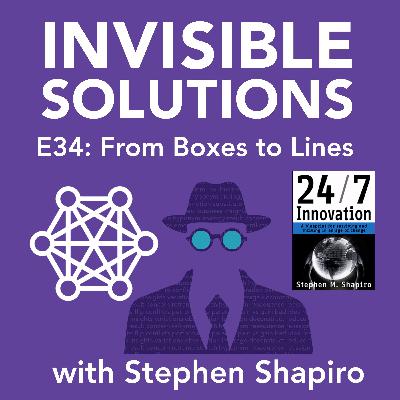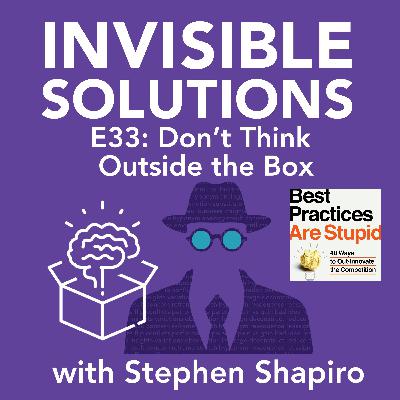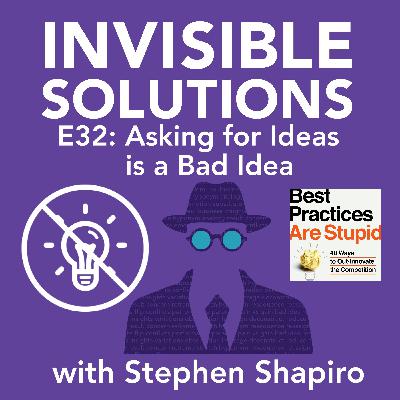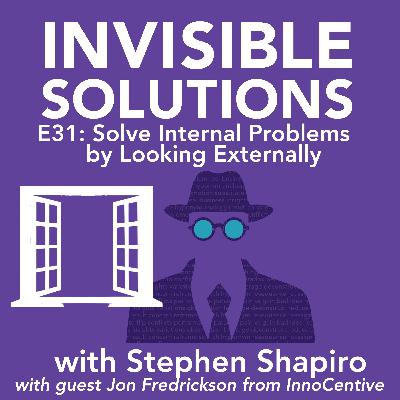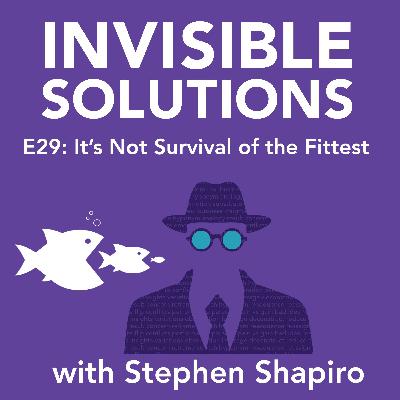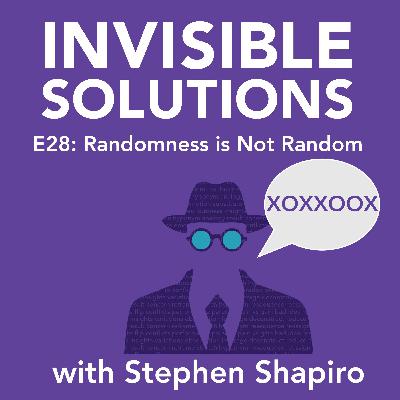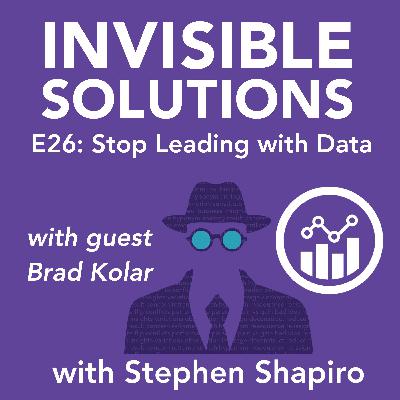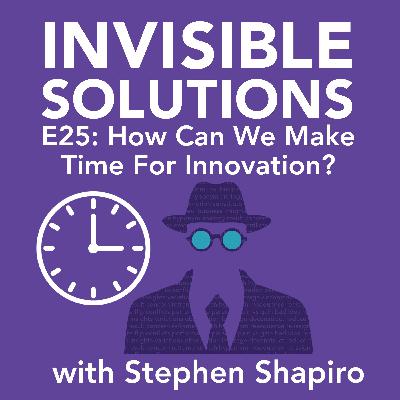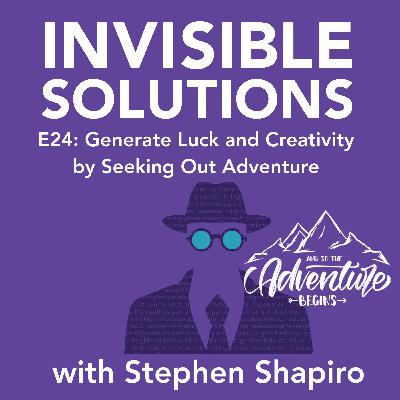Discover Invisible Solutions
Invisible Solutions

Invisible Solutions
Author: Stephen Shapiro
Subscribed: 11Played: 327Subscribe
Share
© 2022 Stephen Shapiro
Description
In today’s complex world, everyone is struggling with challenges they’ve never dealt with before, or persistent problems that won’t go away.
But what if you could find solutions to these problems quickly and systematically?
Join Stephen Shapiro and special guests each week as they solve your real-world problems, real-time using his 25 years of innovation experience.
If you and your business want to solve your difficult problems once and for all, this is the podcast for you.
But what if you could find solutions to these problems quickly and systematically?
Join Stephen Shapiro and special guests each week as they solve your real-world problems, real-time using his 25 years of innovation experience.
If you and your business want to solve your difficult problems once and for all, this is the podcast for you.
37 Episodes
Reverse
Want to be a better problem solver? What if the solution is to get in the mud?In this episode, I interview Joe De Sena. He's the founder of Spartan and is the host of CNBC's No Retreat: Business Bootcamp.This incredibly powerful show puts business people in physically challenging situations as a way of getting them to be more resilient.In this episode, here are some of the questions we tackle:Why Spartan? He feels that businesspeople need to treat themselves like an Olympian - going for the gold medal.Why the TV Show? A lot of people like the idea of being in business but might not be fully committed.What is the Show? The use of military-style training, tackling obstacles to build resiliency skills.Why Physical Challenges? If you can master being under tremendous physical and mental stress and still push through and keep it together, you're unbreakable.Why Do Businesses Fail? Most businesses fail because they quit when it gets hard.How is the Show Constructed? Each week, three business issues are identified and then physical challenges are constructed to help them get stronger in dealing with them.Why Does It Work? He uses an analogy on how steel is made:you heat it, pound it, and then drown it. His physical process is about tackling the problems and searing it into their brains.What are the Results? Each week, at the end of the show, the positive impact is shared. For example, one company increased sales 170% in just three months.How Has This Been Applied to Your Business? Joe shares how the pandemic decimated the Spartan business and how his process helped keep the company afloat (this is a very compelling story).What are the Three Top Challenges for Businesses? 1) Communication, 2) Process (having Standard Operating Procedures), and 3) Cash.And we covered so much more.We also discovered that we both are Cornellians who lived in Boston and now live in the Orlando area. Small world.This is an episode you won't want to miss. Please share it with others who might find it valuable. And be sure to watch the show on CNBC: https://www.cnbc.com/no-retreat/
In this freeform podcast episode, I share my thoughts on my next book: DIVOT.A divot is a term from golf. It's when you swing at the ball, if you go too deep, a chunk of grass goes flying, and this is a divot.And that's the premise of the next book - how can we go deep and create more customer value?Rather than changing direction (pivot) it is about deep value creation.In this episode, I cover a number of different topics related to the book:Where do we double down on our investments?How can we identify our differentiator and use that to prioritize investments?How can the divot help create employee engagement and reduce burnout?How can we best motivate employees (compensation, community, contribution)?How can we provide stability for our employees (vs feeling like employees are working in quicksand)?Why divoting is not the about standing still but is about going deeper.The 5D of Differentiation (Distinctive, Desirable, Durable, Disruption-Proof, Disseminated)Why we want a laser focus on investments rather than diluting and dissipating our energies...and much moreI cover a lot of territory in this episode!If you have any stories to contribute to the new book, please drop me a line. P.S. Note that the title may change. The content might shift. And in the end it might be something other than a book. But the general philosophy of whatever I create will remain the same.
To celebrate Thanksgiving here in the United States, I decided to share this segment from my book, Goal-Free Living. Chapter 4 is entitled, "Want What You Have." Instead of looking for more and creating a different future, appreciate what you have now.Before we get to the podcast, I want to share two items:My "Purple Monday" sale - $50 off the Personality Poker® Starter Kit and a free copy of Best Practices are Stupid if you buy a copy of Invisible Solutions. Sale ends December 3rd. Learn more here: https://stephenshapiro.com/purple-monday/The launch of my new yearlong peer-to-peer mastermind as just announced. Learn more at www.invisiblesolutionsmastermind.com. If you qualify and this is of interest to you, please schedule a discovery call to explore this further.In the podcast I share a number of stories that will hopefully inspire you to have a deeper appreciate for where you are in life, even if things are challenging at the moment.Happy Holidays!
This podcast celebrates 20 years since the launch of my first book, 24/7 Innovation. It also marked the time when I left Accenture and started my own innovation business. In honor of this special period in my life, I read the Prologue to that book and share some thoughts on where we have come in the last two decades.In this episode, we explore:how innovation and management theory have followed the times of the day (from Taylor to today)why past innovation strategies have focused on "boxes" (activities) while newer models focus on "lines" (interconnections) why jazz is a good metaphor for innovation in that it is a collaborate and improvisational approach that adapts to new realitiesthe recent progress innovation has made to move towards "lines" rather than boxeswhy relevance and adaptability is more important than ideas or noveltyThank you to everyone who has made the past 20 years possible!Stephen
What if instead of thinking outside the box, you want to find a better box?This is Chapter 4 from Best Practices are Stupid.We explore the power of Challenge-Centered Innovation (CCI) and why it leads to higher ROI than idea-driven innovation.In this episode, we exploreEinstein's perspective on innovation (hint: the problem is more important than the solution)Hollywood's point of view on thinking outside the box (hint: don't)The advantages of Challenge-Centered InnovationThe key things you do up-front with CCI: assign owners, sponsor, resources, funding, evaluators and evaluation criteriaHow ideas are like fishing with a net in the middle of the ocean while CCI is like targeted fishing with the right lure.The content in this episode is crucial to my overall work and sets the stage for future chapters.
What if asking for ideas is a bad idea? In this episode, I share Chapter 3 from Best Practices are Stupid. In it, we explore why looking for a quantity of ideas can be the downfall of your innovation efforts.You will hear:How several companies started with idea-driven innovation programs that led to the demise of their innovation effortsWhy the signal-to-noise ratio might be one of the most important measures to consider for innovationThe three categories of ideas, and why suggestion boxes lead to a lot of dudsWhy idea programs can be useful for PR or for getting people on-board with innovation, but not for ROIThe behind-the-scenes story of the Deepwater Horizon oil spill innovation efforts This episode provides one of the cornerstones of my work. In the next Best Practices are Stupid episode, we will go even deeper when we explore why you don't want to think outside the box.
What if the best solutions to your internal business problems can be found by looking externally? In this episode, I have a conversation (using the Invisible Solutions® lenses) with my friend and colleague Jon Fredrickson. He is the Chief Innovation Officer for InnoCentive (a Wazoku company) and has 15 years of deep open innovation experience.The conversation covered a wide range of topics including:According to a study conducted by Harvard, over 80% of solvers of InnoCentive challenges would not fit the hiring profile of the clientOne company replicated 15 years of R&D history with one problem with a 60 day challenge - and they got a better answerIf you start looking externally, you can find a kernel of a solution which can be brought back to the organization and adaptedOpen innovation enables parallel processing of problem-solving which can speed time to solutionThere were so many stories, such as how a radiologist solved a problem on how to identify fractures and fissures in the bottom of the Gulf of Mexico to find natural gas or oil deposits.I think you'll really find this conversation fascinating.Learn more about InnoCentiveLearn more about WazokuRead about my strategic partnership with Wazoku/InnoCentiveGet the Invisible Solutions® Lenses
Chapter 2 from Best Practices are Stupid: How Can You Avoid Becoming a One-Hit Wonder?Last week in Chapter 1, I explained the three levels of innovation (event, capability, system). In this week's episode I share more details on what it takes to create level 2 - an innovation capability.When you think about innovation as a repeatable and predictable process/capability like any other part of the business (e.g., finance), it opens up some new perspectives.An innovation capability contains 5 components:StrategyMeasuresProcessPeopleTechnologyWe explore all 5 components briefly - which sets the stage for the rest of the book. The remainder of Best Practices are Stupid is organized around these pieces.NOTE: Although it is not made clear in this chapter, one key difference between an innovation capability and (for example) a finance capability is involvement. Finance is a department with a limited number of people. Innovation is not. Innovation needs to involve the entire organization whenever possible. The role of the innovation team is to set standards and processes that the rest of the organization can use. More on that in later chapters.
In this episode, we explore why speed and power do not lead to long-term innovation. It's not survival of the fittest; it's survival of the adaptable. The content in this episode is from Chapter 1 of my Best Practices are Stupid book.We explore why the ability to repeatedly and predictable evolve your organization is the key to long-term success. I share the three levels of innovation:Innovation as an eventInnovation as a capabilityInnovation as a systemThis is the first episode where I share content from my Best Practices are Stupid book. Moving forward, every other week, I will share a chapter from the book. And then alternating with that content will be my problem-solving episodes.As this is a different format, I would love your feedback. Please go to www.invisiblesolutionspodcast.com to provide me your thoughts.As always, you can download the lenses at www.getthelenses.com
We assume randomness lacks a pattern. But there are inherent patterns in randomness. Unfortunately, our brain is wired to find patterns even when they don't exist in order to create shortcuts that speed decision-making. But what if this very process can lead us down the wrong path?In this episode, I start with a fun experiment where I show my (pseudo) psychic abilities. I think you'll like this, so be sure to give it a try.We then explore how pattern seeking can lead us to focus on the wrong problem.I share a client example where they made assumptions about a problem when in fact the real problem was something completely different - caused by a different department. This is an illustration on Lens #21: REAL PROBLEM.Finally, we tackle the topic of confirmation bias where I share a fascinating study that was conducted by the US Army to see how analysts make good (and not so good) decisions.To download the lenses go to GetTheLenses.comTo submit a problem you want solved on this show go to InvisibleSolutionsPodcast.comTo download the US Army study on confirmation bias, go here
On today's episode, we look into ways of "cloning" someone digitally. In particular, we discuss how to take the knowledge from someone's brain and convert it into workable tools. The problem statement we start with is, "How can we create software that is so great that customers will be mad if we take it away?"My guest problem solver is Adam Leffert, a freelance, C#, .Net Software Architect and Developer based in the Boston area. And he is the creator of the Invisible Solutions® Tools.We use the Invisible Solutions® Lenses Chatbot as an example. This conversational tool asks you questions that walk you through the process of finding the best lenses to apply to your problem. We discuss the design principles behind the tool and then we use the lenses to identify ways to enhance the software.The lenses we primarily used are:#14: EMOTION - What emotion do we want people to feel? In this case, anger if the software is taken away.#6: ANALOGY - Who else has solved a similar problem? How do medical chat bots help diagnose illnesses?#3: REDUCE - What if we reduced the size of the problem set? What if instead of focusing on all 25 lenses, how can we go deeper into the 10 lenses that are used most often and have the widest applicability? This is related to lens #1: LEVERAGE.#11: RESEQUENCE - How can we change the timing of the work? How can we get input earlier in the process of developing the software? How can we communicate asynchronously?#24: VARIATIONS - Instead of designing for the exception, how can we design to handle the exception?#4: ELIMINATE - What can we remove from the software to make it easier to use and/or easier to develop?Learn more about the Invisible Solutions® Tools and take advantage of trial access to the Lens Browser. The Chat Bot that we discussed during this episode is still under development.To download the lenses, go to www.GetTheLenses.com
In order to sell your ideas, you need to be better at using data. But what if leading with data might be the very thing that prevents you from selling your ideas?On this episode, I am joined by my friend and colleague, Brad Kolar. He and I worked closely together at Accenture. He was also the Chief Learning Officer for the University of Chicago Medical Center. Now he helps overwhelmed leaders make better decisions by reducing complexity and increasing clarity.The problem we tackle: "How can we drive data-driven decision-making forward without having to rehash the analysis and background each time we start a conversation?"During the conversation, we used three of the lens from Invisible Solutions:#11: RESEQUENCE - What can we do earlier in the process to increase the speed of buy-in later in the process?#14: EMOTION - Instead of focusing on facts and data, how we can leverage stories and emotion to increase acceptance?#4: ELIMINATE - What if we eliminated the use of charts and statistics in our sales pitch? How could that help improve buy-in?It was a fast-paced and engaging conversation! This is one you won't want to miss!To connect with Brad, go to www.availadvisors.com or LinkedInTo get the lenses, go to www.getthelenses.com
In this week's episode, I am joined by my guest Dan Kaus. Together we tackle the problem: "How can we find time for innovation?" Dan has innovation experience with a wide range of companies and industries, including Accenture, BP, Campbell's Soup, and many others.Dan shared some of this thoughts on this, including:Try to integrate innovation into daily work rather than keeping is separateSimplify innovation so there is less confusionEnsure implementation of high-value ideasWe also explored how using the Invisible Solutions lenses can provide some new insights into this problem. In particular, we used:#1: LEVERAGE - What is the part of the innovation process that will have the greater impact? Where is there currently the biggest bottleneck?#2: DECONSTRUCT - What are the steps of the innovation process and where should we focus?#3: REDUCE - How can we simply the innovation process by reducing steps, ambiguity, or ideas to implement?#7: RESULT - Why do we care about innovation? What's the ultimate goal?#12: REASSIGN - How can we leverage outside resources to help us make innovation a reality?It was a fascinating conversation that I know you will find valuable!You can connect with Dan on LinkedIn at www.DanKaus.comTo download the lenses, go to www.GetTheLenses.com
In this episode, we explore the power of adventure and new experiences as a means for improving luck, increasing creativity, and enhancing problem-solving skills. This episode is dedicated to the memory of my friend, Dr. Jeff Salz, the quintessential adventurer, who passed away last month.This week we cover:Luck: How being open to ANY outcome (vs looking for a specific outcome) increases the probability of luckCreativity: Why collecting and connecting new experiences is a key to enhanced creativity.Adventure: We learn from Jeff Salz and his thoughts on why adventure helps you overcome fear and take on new opportunities.
Thought leaders for years have told people what to do. They write books, shoot videos, give speeches, and create online training programs. Consultants on the other hand do all of the heavy lifting for their clients, implementing the solutions. But what if the key to creating more value for your customers/clients – and for your business – requires a different type of solution?In this episode, I share three categories of support you can provide your clients:Tell me - tell people what to doEnable me - give them the tools so that they can do it on their ownDo it for me - implement the solution for your clientAs you will hear, the "enable me" category might be the one with the greatest value to your clients and to your business.
Marketers will tell you the importance of growing your network. But what if the key to long-term success is about nurturing your network? In today's episode we explore some power of creating deep relationships versus a large number of transactions.A question I am often asked is, "How can we market our business to attract new customers?" This implies the goal is to get more customers. But what if (assuming you have an established business) you already have all of the customers you need? Maybe marketing is not the answer (or more accurately, the question).I explore a number of different ways to improve your business using the lenses. The ones I focus on this week are:#4: ELIMINATE - What if we stopped all marketing efforts?#18: PERFORMANCE PARADOX - What if instead of selling to customers, you serve them instead?#24: VARIATIONS - Focus your efforts on the clients where you can create the greatest value.How can you build a deeper relationship with the past customers where you can make the greatest impact? This is quite different than focusing on marketing.
Scaling a service-based business isn't easy. Especially if you are a solopreneur who doesn't want to hire employees or have expensive overhead. Short of cloning yourself or working 24 hours a day, what's the solution?A question I am often asked by my professional speaker, consultant, and training colleagues is, “How can we scale my service-based business without hiring a lot of employees?”In this episode, we will address this questions by using six lenses from Invisible Solutions that will provide a half-dozen different ways to grow your business - without hiring anyone.The lenses are:#4 Eliminate – what can you stop doing?#11 Resequence –how can you change the timing?#12 Reassign – who can help you scale - and how?#13 Access – how can you create a subscription?#6 Analogy –who else has solved a similar problem?#34 Variations – how can you treat different customers/clients differently?Although this might seem like a lot of lenses, this question is so rich with opportunity that I didn't want to shortchange listeners.I think you'll enjoy this one, especially if you have a service-based business.Download the lenses from Invisible SolutionsSubmit any problems you want me to solve on the show
It gets easy to fall into the trap of equating novelty with innovation. But they are not the same. Value and relevancy are what matter with innovation. In this episode, we explore how to make sure you are solving the real problem. Instead of focusing on your own strengths, identify the needs of your customers.We also spend some time exploring lens #22: REAL BUSINESS. What business are you really in? Realizing I wasn't in the business I thought I was helped me rethink everything I do.To illustrate the points, I share stories from Kodak and UPS.I also publicly announce the launch of The Problem-Solving Institute. Enjoy!The Problem-Solving InstituteMy Inc article on why you should not worry about novelty
In this episode, I share three useful tricks every innovator should steal from magicians. Then I share one of my favorite lenses - #24: VARIATIONS.The three tricks to steal are:Don't trust the brainStart with the impossible solution.Performance is as important as the method.I also share why simplification is often the best form of innovation. The most complicated solutions is not always the best solution.Then I talk about lens #24: VARIATIONS.The premise of this lens is that you should not design your solutions with a one-size-fit-all strategy. Or in other words, design to handle the exception, not for the exception.Download the lenses from Invisible SolutionsSubmit any problems you want me to solve on the showLearn more about the "Best Practices are Stupid" book where you can read my "Making the Impossible Possible" technique
When looking for solutions to your problems, it seems logical to turn to best practices for answers. But what if best practices are stupid? What if they are not the key to innovation or problem-solving and may lead you down the wrong path?In this episode, we explore three reasons why best practices may be a bad idea:Replication is not innovation - copying someone else will not help you differentiateContext matters - just because it worked for someone else, doesn't mean it is right for youUndersampling of failure - was the best practice really the cause of success, or is it a correlation or (even worse) a coincidence)?We also explore lens #6: ANALOGY. Although it may appear that this lens suggest we use best practices, it actually means something quite different.You will never hear the term "best practice" the same way ever again!Download the lenses from Invisible SolutionsSubmit any problems you want me to solve on the showLearn more about the "Best Practices are Stupid" book





